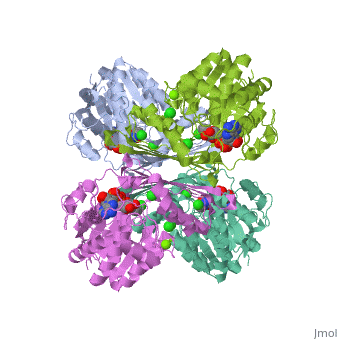Birrer Sandbox 1
Mechanism of TrypsinMechanism of Trypsin
To begin, typsin is folded into a two domains, and it contains numerous areas of anti-parallel beta sheets while having little helix. At the active site, Ser 195, His 57, and Asp 102 form what is referred to as the catalytic triad (PDB id 2age)[1], which is a hydrogen-bonded constellation. At the bottom of the binding pocket is the anionic residue, Asp 189. With the neighboring cationic side chains of Arg, and Lys, Asp 189 can form ion pairs.
| |||||||||
| 2age, resolution 1.15Å () | |||||||||
|---|---|---|---|---|---|---|---|---|---|
| Ligands: | |||||||||
| Non-Standard Residues: | |||||||||
| Activity: | Trypsin, with EC number 3.4.21.4 | ||||||||
| Related: | 2agg, 2agi, 2ah4
| ||||||||
| |||||||||
| Resources: | FirstGlance, OCA, PDBsum, RCSB | ||||||||
| Coordinates: | save as pdb, mmCIF, xml | ||||||||
The mechanism of catalysis is pretty involved but the important parts are the tetrahedral intermediate which decomposes to an acyl-enzyme intermediate before adding water and decomposing to the original enzyme. In step 1, Ser 195 acts as a nucleophile and attacks the scissile peptide’s carbonyl group, forming a tetrahedral intermediate. During the attack, Ser 195 transfers a proton to His 57’s imidizole. Step 2 involves the donation of a proton from the 3rd nitrogen in His 57, causing the decomposition of the tetrahedral intermediate. The polarization of Asp 102 and His 57 facilitates this process. In step 3, a water, from solvent, displaces the amine leaving group from the enzyme. In step 4, the acyl-enzyme intermediate undergoes the addition of water, which returns the enzyme to a tetrahedral intermediate and effectively reverses step 2. In the final step, Water attacks as a nucleophile, displacing the Ser 195 leaving group, and this is essentially the reversal of step 1, and the active enzyme is regenerated.

